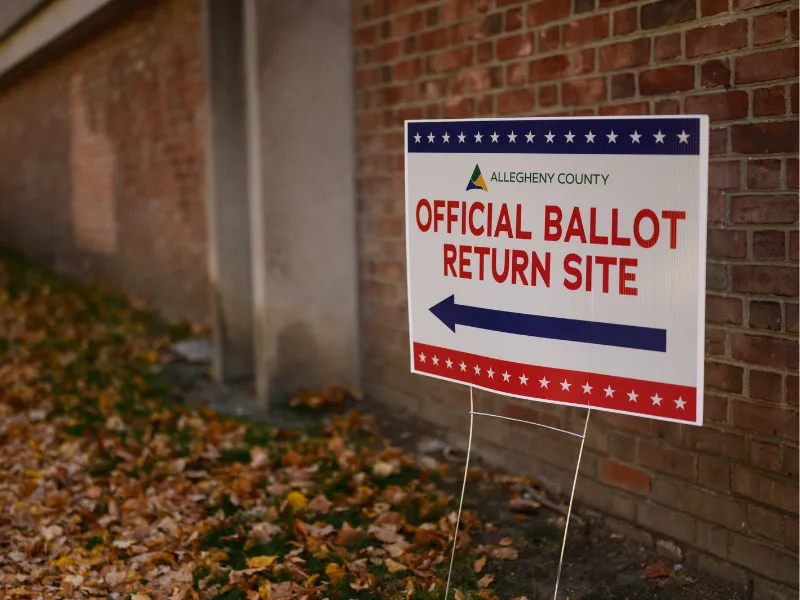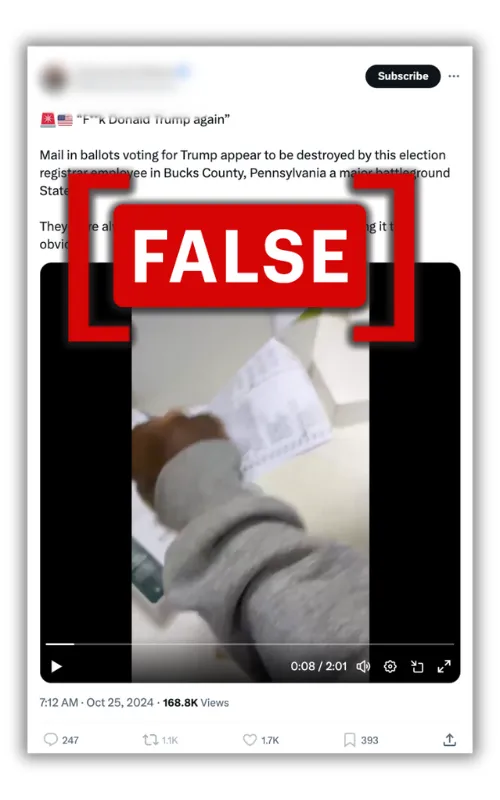By: Nikolaj Kristensen
November 5 2024
 A sign directs people to the ballot drop-off location at the Carnegie Library of Pittsburgh in Pittsburgh’s Squirrel Hill neighborhood on Sunday, November 3, 2024. (Justin Merriman/Sipa USA/Reuters Connects))
A sign directs people to the ballot drop-off location at the Carnegie Library of Pittsburgh in Pittsburgh’s Squirrel Hill neighborhood on Sunday, November 3, 2024. (Justin Merriman/Sipa USA/Reuters Connects))
A week ahead of the election, former president Donald J. Trump took the stage at a campaign rally in Allentown, Pennsylvania, to the tones of Lee Greenwood's God Bless The U.S.A., wearing his standard uniform: navy blue suit, white shirt, red tie, Stars & Stripes pinned to his lapel. Before him, an ocean of red caps and out-stretched hands with video-recording smartphones. He was talking for less than five minutes before saying: "They've already started cheating in Lancaster, they've cheated. We caught them with 2,600 votes. We caught them cold."
The same day, he repeated the claim on Truth Social that Lancaster County had been "caught with 2600 Fake Ballots and Forms." He also claimed that York County, also in Pennsylvania, had "received THOUSANDS of potentially FRAUDULENT Voter Registration Forms and Mail-In Ballot Applications." The day after, he wrote: "Pennsylvania is cheating, and getting caught, at large scale levels rarely seen before."
.webp) Screenshot of Trump's Truth Social post claiming voter registration fraud in Lancaster County, Pennsylvania. (Source: Truth Social/@realDonaldTrump/Screenshot)
Screenshot of Trump's Truth Social post claiming voter registration fraud in Lancaster County, Pennsylvania. (Source: Truth Social/@realDonaldTrump/Screenshot)Some days before, Lancaster County officials had identified approximately 2,500 suspected fraudulent voter registration forms (the county has 366,000 registered voters). Voter registration forms or applications are requests from a person to be added to voter rolls—they are not the same as a ballot. An early statement from the county did say they were investigating "ballots," but an official told PolitiFact that was a typo.
Officials said the identification and containment of potentially fraudulent applications proved the county's election system to be secure and working.
"This is a sign that the built-in safeguards in our voter registration process are working," said Al Schmidt, the secretary of the Commonwealth of Pennsylvania, in a statement.
In York County, officials had identified 3,087 questionable voter registration applications —again, not ballots— 24 percent of which were denied after a review by the elections office. Officials released a statement saying the "elections staff has been working diligently to process each of those applications and is analyzing every document to ensure each application was completed legitimately and legally."
Pennsylvania Attorney General Michelle Henry said in a press release that apparent attempts to submit fraudulent voter registration forms in York, Lancaster, Berks, and Monroe counties have been defeated. "While we will not be divulging sensitive information about these investigations, we want to clarify that the investigations regard voter registration forms, not ballots. These attempts have been thwarted by the safeguards in place in Pennsylvania," she said.
Trump is not the only person making claims of voter ballot fraud in Pennsylvania. More of the same is circulating online.
One video shared online claimed to show election workers ripping up ballots. Federal officials said Russian actors manufactured and amplified the video.

Another video from outside an election office in Allegheny County was claimed to show "illegal voters" being sent to polling locations to vote for Kamala Harris. But Allegheny County officials said it was a group of U.S. citizens that had come to apply for mail-in ballots.
A video of a man dropping off a container of ballots at a courthouse in Northhampton County, Pennsylvania, was shared on X in posts alleging suspicious activity. It turned out he was a postal worker delivering mail-in ballots.
It's hardly a coincidence that Pennsylvania's voting processes have come under such scrutiny. Pennsylvania has been called "2024's most important swing state," the "biggest" or "top prize" among battleground states, and "the crucial battleground" that could "decide the winner of the 2024 election."
Both campaigns spent considerably more money on political advertising in Pennsylvania than in any other swing state this cycle, according to AdImpact, a firm that tracks political ad purchasing. As of October 7, the campaigns had spent 279.3 million dollars on ads in Pennsylvania, followed by Michigan where they've spent 203.7 million dollars.
Both campaigns have traveled more to Pennsylvania than any other swing state.
And the day before Election Day, guess where both candidates were campaigning? Yes, Pennsylvania.
For one thing, the state holds the most electoral votes (19) of any of the battleground states (North Carolina - 16. Georgia - 16, Michigan - 15, Arizona - 11, Wisconsin - 10, Nevada - 6), making it key to any successful path to the White House.
Pennsylvania's demography makes it competitive for both presidential candidates. Its urban populations, especially in Philadelphia and Pittsburgh, are usually Democratic-leaning, while its rural populations are usually Republican-leaning.
Also, Pennsylvanians know how to pick a winner, voting for 10 of the last 12 presidents and hitting the head on the proverbial nail in every election from Obama in 2008 onwards.
Pennsylvania—along with Michigan and Wisconsin— is part of the Rust Belt "blue wall," a group of states that routinely vote Democrat, at least since the 1992 election. This changed in 2016 when Trump flipped the state before Biden flipped it back again in 2020.
If Trump can manage to flip Pennsylvania and Georgia—and assuming he holds the states he won in 2020—he becomes president. If he doesn't flip Pennsylvania, he'll have to flip three states in order to become president. (Biden flipped both Georgia and Pennsylvania in 2020.)
Harris, too, has a lot on the line in the Keystone State. Not since 1948 has a Democrat won the White House without Pennsylvania.
Good question. In 2016, the winner of Pennsylvania was announced (very) early the next morning. In 2020 it famously took four days to announce a winner. Pennsylvania voting law dictates that mail-in ballots can't be preprocessed or counted before 7 a.m. Election Day. This delays the process as the ballots then have to be counted at the same time all the other ballots are coming in.
But still, there's reason to believe it won't take four days this time around. In 2020, Pennsylvania saw a large number of mail-in ballots, 2.6 million in total. Due to the COVID-19 pandemic, the state had changed its voting law so that voters no longer needed an excuse to vote by mail. This year there have been considerably fewer mail-in votes (2.2 million), and Pennsylvanian counties have invested in machines to help speed up the counting process.
Follow Logically Facts' coverage and fact-checking of the U.S. Election 2024 here.